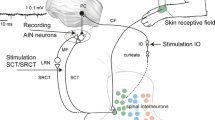Summary
When recording intracellularly from cat's Deiters neurones, stimulation of the anterior lobe of the cerebellar cortex produced excitatory postsynaptic potentials (EPSPs) monosynaptically, in addition to the inhibitory ones (IPSPs) that were identified previously as being produced via Purkinje cell axons. The EPSPs were induced bilaterally from a wide area of the anterior and posterior lobes of the cerebellum, in contrast to the IPSPs that were evoked only ipsilaterally, mainly from the vermal cortex. The latency of the EPSPs was slightly, but significantly, shorter than that of the IPSPs. The presynaptic impulses responsible for these EPSPs were represented by the discrete field potentials and also by unit spikes of individual fibres. The pathway for these EPSPs and presynaptic impulses was pursued by testing their interference, in the manner of impulse collision and refractoriness, with those induced from various spots within or outside the cerebellum. It is found that the excitatory fibres for Deiters neurones extend transversely, and probably longitudinally too, over the culmen and pass out of the cerebellum through cerebellar peduncles. The major portion of them appears to originate from the medulla and a minority from the spinal cord. It is postulated that cerebellar afferents from these structures have synapses with Deiters neurones via their collateral branches, through which a kind of axon reflex occurs to Deiters neurones during stimulation of the cerebellar cortex.
Similar content being viewed by others
References
Angaut, P., and A. Brodal: The projection of the vestibulo-cerebellum onto the vestibular nuclei in the cat. Arch. ital. Biol. 105, 441–479 (1967).
Brodal, A.: Experimentelle Untersuchungen über die olivo-cerebellare Lokalisation. Z. ges. Neurol. Psychiat. 169, 1–153 (1940).
—: Experimental demonstration of cerebellar connexions from the peri-hypoglossal nuclei (nucleus intercalatus, nucleus praepositus hypoglossi and nucleus of Roller) in the cat. J. Anat. (Lond.) 86, 110–129 (1952).
—: The cerebellar connections of the nucleus reticularis lateralis (nucleus funculi lateralis) in rabbit and cat experimental investigations. Acta psychiat. (Kbh.) 18, 171–233 (1943).
—, and B. Høivik: Site and mode of termination of primary vestibulo-cerebellar fibres in the cat. Arch. ital. Biol. 102, 1–21 (1984).
—, O. Pompeiano and F. Walberg: The vestibular nuclei and their connexions. Springfield/ Ill.: Charles C. Thomas 1962.
—, and A. Torvik: Cerebellar projection of paramedian reticular nucleus of medulla oblongata in cat. J. Neurophysiol. 17, 483–495 (1954).
Eccles, J.C., M. Ito and J. Szentágothai: The Cerebellum as a Neuronal Machine. Berlin-Heidelberg-New York: Springer 1967.
—, R. Llinás and K. Sasaki: The excitatory synaptic action of climbing fibres on the Purkinje cells of the cerebellum. J. Physiol. (Lond.) 182, 268–296 (1966a).
—: The mossy fiber-granule cell relay in the cerebellum and its inhibition by Golgi cells. Exp. Brain Res. 1, 82–101 (1966b).
Grant, G.: Spinal course and somatotopically localized termination of the spinocerebellar tracts. An experimental study in the cat. Acta physiol. scand. 56, Suppl. 193 (1962).
Ito, M., and M. Yoshida: The origin of cerebellar-induced inhibition of Deiters neurones. I. Monosynaptic initiation of the inhibitory postsynaptic potentials. Exp. Brain Res. 2, 330–349 (1966).
—, T. Hongo and Y. Okada: Vestibular-evoked postsynaptic potentials in Deiters neurones. Exp. Brain Res. 7, 214–230 (1969).
—, M. Yoshida, Y. Okada and K. Obata: Antidromic and trans-synaptic activation of Deiters' neurones induced from the spinal cord. Jap. J. Physiol. 14, 638–658 (1964).
-, N. Kawai and M. Udo: The origin of cerebellar-induced inhibition and facilitation in the neurones of Deiters' and intracerebellar nuclei. XXIII Int. Congr. Physiol. Sci., Tokyo, 997 (1965).
—: The origin of cerebellar-induced inhibition of Deiters neurones. III. Localization of the inhibitory zone. Exp. Brain Res. 4, 310–320 (1968a).
— and N. Sato: Cerebellar-evoked disinhibition in dorsal Deiters neurones. Exp. Brain Res. 6, 247–264 (1968b).
Ito, M., K. Obata and R. Ochi: The origin of cerebellar-induced inhibition of Deiters neurones. II. Temporal correlation between the trans-synaptic activation of Purkinje cells and the inhibition of Deiters neurones. Exp. Brain Res. 2, 350–364 (1966).
Larsell, O.: The cerebellum of the cat and the monkey. J. comp. Neurol. 99, 135–200 (1953).
Lorente de Nó, R.: Études sur le cerveau postèrieur. III. Sur les connexions extracerebelleuses des fasicules afférentes au cerveau, et sur la fonction de cet organe. Trav. Lab. Rech. Biol. 22, 51–65 (1924), quoted from wilson et al. (1966).
—: Vestibulo-ocular reflex arc. Arch. Neurol. Psychiat. (Chic.) 30, 245–291 (1933).
Lundberg, A., and O. Oscarsson: Functional organization of the ventral spino-cerebellar tract in the cat. IV. Identification of units by antidromic activation from the cerebellar cortex. Acta physiol. scand. 54, 270–286 (1962).
Oscarsson, O.: Functional organization of the spino- and cuneocerebellar tracts. Physiol. Rev. 45, 495–522 (1965).
—, and N. Uddenberg: Identification of a spinocerebellar tract activated from forelimb afferents in the cat. Acta physiol. scand. 62, 125–136 (1964).
Pompeiano, O., and A. Brodal: Spino-vestibular fibers in the cat. An experimental study. J. comp. Neurol. 108, 353–381 (1957).
Szentágothai-Schimert, J.: Die Bedeutung des Faserkalibers und der Markscheidendicke im Zentralnervensystem. Z. Anat. Entwickl.-Gesch. 111, 201–223 (1941).
Torvik, A., and A. Brodal: The cerebellar projection of the perihypoglossal nuclei (nucleus intercalatus, nucleus praepositus hypoglossi and nucleus of Roller) in the cat. Neuropath. exp. Neurol. 13, 515–521 (1954).
Verhaart, W.J.C.: A stereotaxic atlas of the brain stem of the cat. Assen: Van Gorcum 1964.
Wilson, V.J., M. Kato, R.C. Thomas and B.W. Peterson: Excitation of lateral vestibular neurones by peripheral afferent fibres. J. Neurophysiol. 29, 508–529 (1966).
—, B.W. Peterson and R.M. Willie: A single-unit analysis of the organization of Deiters' nucleus. J. Neurophysiol. 30, 603–619 (1967).
Author information
Authors and Affiliations
Rights and permissions
About this article
Cite this article
Ito, M., Kawai, N., Udo, M. et al. Axon reflex activation of Deiters neurones from the cerebellar cortex through collaterals of the cerebellar afferents. Exp Brain Res 8, 249–268 (1969). https://doi.org/10.1007/BF00234252
Received:
Issue Date:
DOI: https://doi.org/10.1007/BF00234252




